Working with OSGi applications
A detailed explanation of the OSGi framework is out of the scope of this publication. Refer to the following sources for more information about that topic:
- The home page of the OSGi alliance:
- Eclipse Equinox OSGi implementation:
- The WAS V8.5 Information Center:
OSGi overview
Open Services Gateway initiative (OSGi) is a framework based on Java technology. OSGi enables you to write modular, dynamic, and versioning applications. WAS V8.5 uses the Eclipse Equinox as the framework for OSGi applications and OSGi V4.2.
We can design and build applications from coherent, versioned, reusable OSGi modules that are accessed only through well-defined interfaces. The new features of WAS V8.5 support for OSGi applications includes the following list:
- An OSGi application can contain Enterprise JavaBean (EJB) that allows direct access and invokes an enterprise bean.
- A blueprint configuration file can specify a user role for security access to the methods of the bean.
The OSGi framework in WAS provides support for each of the layers of the OSGi Architecture:
- The Modules layer
- The Life-cycle layer
- The Services layer
OSGi application model
OSGi bundles and bundle archives
The unit of deployment in OSGi is a bundle. A bundle is a standard JAR or WAR file with additional metadata in the manifest file. Because the standard Java environment ignores these additional properties, we can also use an OSGi bundle with classic Java applications.
There are several bundles and bundle archives within an OGSi application:
- Enterprise bundle archives
An enterprise bundle archive file contains a set of OSGi bundles deployed as a single OSGi application and isolated from other OSGi applications. Bundles that belong to an OSGi application can reference other bundles that are in the shared bundle repository.
The external bundles referenced do not have to be included within the application as long as the originating bundles import the required packages and the external bundles export these packages as well.
- Composite bundles
A composite bundle actively groups shared bundles together into a composite bundle archive file. This grouped bundle acts as a single bundle from the user perspective. It provides one or more packages at exact versions (not a version range) to an OSGi application. When the OSGi framework resolves a package to a bundle within a composite bundle archive, it has the affinity to resolve the remainder of the packages within the same composite bundle archive.
- Application bundles and shared bundles
Application bundles are instance-specific or isolated, and each instance of an application includes its own instance of the bundle. Shared bundles are shared or not instance-specific, and a single instance of a package or service from a shared bundle can be used by many applications.
- Web application bundles
A web application bundle is a bundle containing a web application and that can be deployed in an OSGi container.
- EJB bundles
An EJB bundle is a bundle containing EJBs and that can be deployed in an OSGi container. An EJB bundle is an OSGi bundle version of an EJB JAR file. It is a new feature introduced in WAS V8.5.
OSGi Bundle Manifest file
The metadata for an OSGi application is defined in manifest files. An OSGi bundle contains a bundle manifest. A composite bundle archive contains a composite bundle manifest. An enterprise bundle archive contains an application manifest. An enterprise bundle archive asset contains a deployment manifest which is generated automatically when the enterprise bundle archive file is imported as an asset.
In this section we focus on the OSGi bundle manifest located under META-INF/MANIFEST.MF.
For other manifest information, refer to the following website: http://www14.software.ibm.com/webapp/wsbroker/redirect?version=phil&product=was-nd -dist&topic=ca_manifest We now check each element of the example manifest shown as Example 27-1.
Example of bundle manifest file, META-INF/MANIFEST.MF
Manifest-Version: 1.0 Bundle-ManifestVersion: 2 Bundle-Name: MyLibrary bundle Bundle-SymbolicName: com.sample.mylibrary Bundle-Version: 42.0.0 Bundle-Activator: com.sample.mylibrary.Activator Import-Package: org.osgi.framework;version=”[1.0.0,2.0.0)” Export-Package: com.sample.mylibrary.stringops;version=23.2.1,com.sample.mylibrary.integerops;ver sion=5.0.0 Meta-Persistence: entities/persistence.xml, lib/thirdPartyEntities.jar!/META-INF/persistence.xml Web-ContextPath: /contextRoot Export-EJB: Bundle-Blueprint: /blueprint/*.xml
The following list explains the elements of the bundle manifest file
- Bundle-ManifestVersion
This header must be set to the numeric value of 2. This value indicates the bundle is written to revision 4 or later of the OSGi specification, rather than previous revisions.
- Bundle-SymbolicName and Bundle-Version
These two headers define the identity of the module. Every bundle in an OSGi system has a unique identity determined by its symbolic name and version. The Bundle-Version header is optional. If the header is not present, the bundle version defaults to 0.0.0.
- Bundle-Activator
This header notifies the bundle of lifecycle changes.
- Import-Package
This header defines the packages that are visible to a bundle. A bundle always has access to all java.* packages, all the packages inside the bundle, and depending on the OSGi framework configuration, the javax.* packages that are part of the JDK. All other packages must be imported. Every package import carries a version range that defines the accepted versions of the dependencies. This version range is entirely independent of the bundle version.
- Export-Package
This header declares the packages that are visible outside the bundle. Only the specified visible packages can be used by other bundles. Every exported package carries a version, which defaults to 0.0.0 if unspecified.
- Meta-Persistence
If the application uses the Java Persistence API (JPA) and this bundle is a persistence bundle, the bundle manifest also contains a Meta-Persistence header. This header lists all the locations of persistence.xml files in the persistence bundle. When this header is present the default location, META-INF/persistence.xml, is added by default.
- Web-ContextPath
This header identifies this bundle as a web application bundle. The value specifies the default context from which the web content is hosted.
- Bundle-Blueprint
This header specifies the location of the blueprint descriptor files in the bundle.
- Export-EJB
This header is new in WAS V8.5. It identifies this bundle as an EJB bundle. This header causes any enterprise beans in the bundle to be loaded and run by the EJB container. The value of this header declares the enterprise beans to export as OSGi services.
The Export-EJB header can have any of the following values:
- A single space character: Export all enterprise beans in the bundle.
- A comma-separated list of the class names of the enterprise beans to export. If an enterprise bean is not included in this list, it is still loaded and run, but not exposed in the OSGi service registry.
- NONE: Do not export any enterprise beans. An exported enterprise bean is registered in the OSGi service registry with the following service properties:
- ejb.name: The name of the enterprise bean.
- ejb.type: The EJB type with the value of this property as either Stateless or Singleton.
- service.exported.interfaces: The enterprise bean is registered with this property only if it has a remote interface. The value is the EJB interface name.
OSGI versioning is the foundation for the OSGi modules dependencies and capabilities. Every bundle or export package (capabilities) has a version number in a specific format, and every import package (dependencies) statement has a version range.
This versioning provides the ability to write modules today that can interoperate with current libraries and with future versions of those libraries but that will fail to resolve against incompatible future versions of those libraries.
OSGi distinguishes between bundle versions and package versions. Versioning a bundle does not version the packages and vice versa.
The OSGi semantic versioning follows this format:
-
<major>.<minor>.<micro>.<qualifier>
- The <qualifier> carries no semantics and is often used to denote build numbers. Such as in Rational Application Developer, the qualifier can be replaced by a build time stamp during export.
- A change in the <major> denotes a breaking API change, for example, the parameters of a method changed.
- A change in the <minor> denotes a backwards compatible API change, for example, adding a new method to an interface. Existing clients can function both with the old and new versions. Implementations can be updated to support the new method.
- A change in the <micro> denotes a bug fix, and no change to the API is allowed.
- [1.0.0,2.0.0)
Defines a version range from 1.0.0 (inclusive) to 2.0.0 (exclusive). A square bracket denotes an inclusive endpoint, whereas a round bracket denotes an exclusive endpoint.
- Each bundle provides visibility only to Java packages that it explicitly exports.
- Each bundle declares its package dependencies explicitly.
- Packages can be exported at specific versions and imported at specific versions or from a specific range of versions.
- Multiple versions of a package can be available concurrently to different clients.
In addition to single versions, OSGi defines the concept of version ranges. We can refer to the version ranges that were used on the Import-Package statements. Version ranges come in the following forms:
Defines an open version range of 1.0.0 and continues through higher versions. Do not confuse open version ranges with single versions. Whether the version is a single version or a range is determined by the context. For example, the Export-Package and Bundle-Version statements have single versions, where as the Import-Package and Application-Content statements have version ranges.
Consideration: Despite operating productively in most development scenarios, the OSGi version policy is not appropriate in all cases. For example, OSGi versions are conceived as linear, , v1.7 must contain all the features of v1.6 (otherwise, a breaking change occurs and the version is actually v2.0). As a consequence, we can introduce new features only on the latest version within one major package version. We cannot introduce features at earlier versions. This limitation can be a problem with large products that maintain a stable API. Stable APIs have infrequent major version changes, but you still need to combine the product with their multiple minor versions that are supported and actively extended.
Also note that it is up to the developer to adjust package versions.
OSGi Class Loader
One key advantage of OSGi is its class loader, which uses the metadata in the manifest file to resolve the classes and resources. When bundles are installed into the OSGi Framework, their metadata is processed. The OSGi Framework works out all the dependencies and calculates the independent required class path for each bundle in the following ways:
OSGi bundle lifecycle
All artifacts in OSGi are equipped with support of dynamics in the form of defined lifecycles.
The following list describes some the stages of the OSGi bundle lifecycle:
- A bundle is first installed into an OSGi runtime environment (called the OSGi framework).
- A process called resolution determines whether all of the bundles’ dependencies can be satisfied.
If successful, the bundle moves to the resolved state and can be started. In this state, classes and resources in the bundle can be used by other bundles. The lifecycle layer ensures that bundles are started only if all their dependencies are resolved. It can reduce the occurrence of ClassNotFoundException exceptions at run time.
- It briefly goes through the starting state where the bundle’s startup class, called an Activator, is executed. At that time, the bundle transitions into the active state. The bundle activator is specified in the bundle manifest.
The bundle activator allows an OSGi bundle to be more than just a provider of classes by actively executing tasks, registering and consuming services, and so on with other tasks.
- At the end of its life, a bundle can be uninstalled from the framework again. However, when uninstalling a bundle, OSGi ensures that any packages the bundle provides to other bundles remain available. OSGi verifies if there any states that still need to be resolved or are active.
Bundles can be installed, started, stopped, and uninstalled independently of each other and independent from the lifecycle of the application server. OSGi bundles are not started unnecessarily but only when explicitly requested or first needed. Even when started explicitly, a bundle author can defer activation to when the first class is loaded from the bundle. This is called lazy activation.
Updates
Bundle and service lifecycles, along with the event notification support that OSGi defines around them, gives developers the tools to build truly dynamic applications. However, even with this support, it remains far from trivial to write code that can cope appropriately with a truly dynamic environment on which services can come and go at any time.The OSGi model allows you to perform live updates of the module during which time the environment normally runs the applications. This method forces OSGi to cope with a bundle that might disappear and then re-appear or be present and active more than once for some interval. This method minimizes down time of server side applications but alternatively also requires a good OSGi design.
OSGi Service
OSGi also introduces a service registry layer used for collaboration between bundles. An OSGi service is published to the service registry under one or more Java interface names with any optional metadata stored as custom properties.Bundles publish services to the service registry, and other bundles can discover them by looking up a service in the service registry. Bundles can filter service registry searches using the interface name and custom properties.
OSGi Applications in WAS usually interact with the OSGi service registry through a Blueprint module definition. POJO bean components, that are described in the Blueprint module definition, can be registered as services through a <service> element or can have service references injected into them through a <reference> element.
Services are fully dynamic, and typically have the same lifecycle as the bundle that provides them. Provider bundles can be stopped and started causing POJO services registered and de-registered, independently of the lifecycle of the consuming bundles. However, bundles can choose to publish and retract services dynamically due to changes in the environment, for example, due to one required service going away or coming back.
Enterprise OSGi
OSGi was originally targeted to support Java Platform, Standard Edition, but Version 4.2 of the OSGi specification introduces additional support for Java Platform, Enterprise Edition.
These extensions allow developers to write an OSGi enterprise application using methods that are similar to writing Java EE applications. The following Java EE technologies are integrated with the OSGi framework:
- Web Application Specification
Defines how to support the Servlet 3.0 and JSP 2.1 specifications in OSGi. Bundles that are built on this support are called web application bundles. Web application bundles must be marked by the Web-ContextPath bundle manifest header.
- JNDI Services Specification
Defines how OSGi bundles can access javax.naming services and how JNDI can be used to access the OSGi service registry.
- JPA Service Specification
Defines the basic support for unmanaged JPA in an OSGi bundle, called a persistence bundle, which must be marked by the manifest header...
-
Meta-Persistence
In particular, the specification defines packaging requirements around persistence bundles and provider selection or integration with the JPA run time.
- Blueprint Container Specification
Based upon the Spring dynamic modules project, Blueprint provides a light-weight, XML-based POJO injection model with special support for the OSGi service registry. The Blueprint XML files define and describe how the components are instantiated and are wired together to form a running module. A Blueprint XML file is used for the following actions:
- Declare beans using the bean element.
- Declare a service element to define the registration of a service in the OSGi service registry.
- Declare a reference element to find services in the service registry or the reference-list element to find multiple matching services.
The specifications allow developers to write an OSGi enterprise application using methods that are similar to writing Java EE applications. Because the OSGi model is non-invasive to the classic Java EE model, both applications can be used in the same run time.
Using the sample application
In this section, we use an ITSOBank sample application to explain the OSGi packaging model. To work with the OSGi application, we use IBM Assembly and Deploy Tools for WebSphere Administration v8.5. However, we can use any other tool that supports the OSGi framework.
Downloading the application
To access and use the sample application:
- To download the sample application, go to the following website: http://www.redbooks.ibm.com/abstracts/sg247835.html?Open
- Click the Additional Material link.
- Click the sg247835.zip file, and select Save to save the compressed file to your computer.
- Extract the compressed file, and find the OSGi_ITSO_example.zip file. This file is located in the 7835codesolution/osgi directory.
Importing the application to the development tool
To use the sample OSGi_ITSO_example application for our exercise, import the projects files into IBM Assembly and Deploy Tools for WebSphere Administration by completing the following steps:
- Start IBM Assembly and Deploy Tools for WebSphere Administration.
- Click...
-
File | Import | Existing projects into workspace | Next
- Click Browse next to the Select root directory, and point to the root folder where you extracted the OSGi_ITSO_example.zip file. Click OK.
- The process discovers the five projects. Click Select All to select all of the projects. Select Copy projects into workspace.
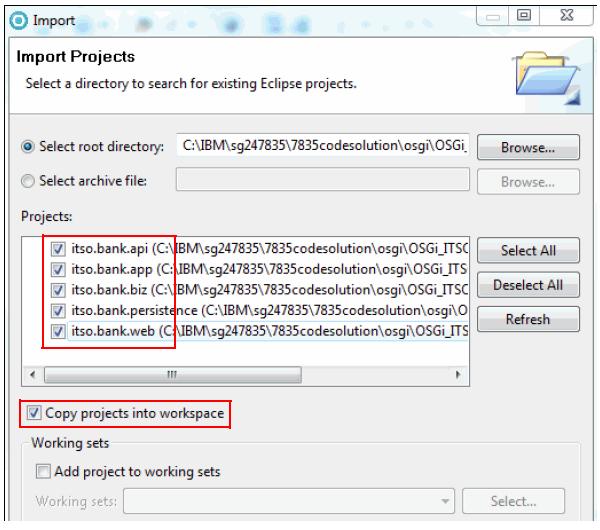
- Click Finish.
- The IBM Assembly and Deploy Tools for WebSphere Administration promotes a Workspace Migration window. Click Select All, and make sure the check boxes of all five projects are selected, and click Next. In the Migration Project Resource window, click Next. In the Undefined Server Runtime window select the WAS V8.5 as New Server Runtime and accept all default settings. In the Complete Migration Startup window, click Finish. After the migration process complete, a dialog confirms the migration completed successfully.

- After the projects are loaded to your workspace, copy all the JAR files used by itso.bank.web bundle from the OSGi_ITSO_example\jar files directory. Then, in the Enterprise Explorer view of the workspace, expand the itso.bank.web application, and paste the files into the WEB-INF/lib directory. Note that this method is only one way to supply libraries to the web project.
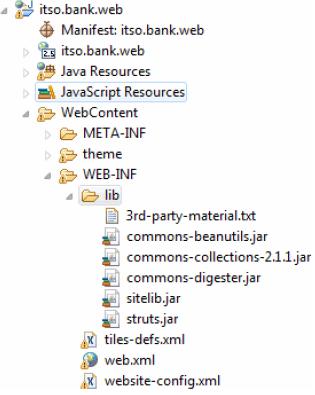
After importing the projects, we can use the Enterprise Explorer perspective to preview the ITSOBank application projects...
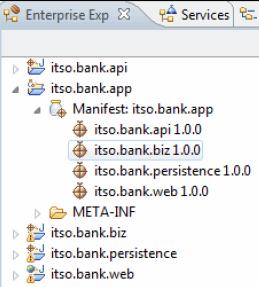
To have a fully operational OSGi ITSOBank application, additional configuration is required, such as configuring the data source on the server.
Packaging OSGi applications
Common OSGi patterns
Consider using the following common OSGi patterns that have special support in the packaging of OSGi applications:
- Web content is packaged in web application bundles.
- Business logic is written as POJOs.
- Bundles share interfaces and services rather than concrete implementations.
- Other bundles depend on services.
- Persistence is achieved through JPA managed persistence.
- Declarative transactions are provided by a custom Blueprint extension.
Sample application packaging
The ITSOBank is a simple application, but it presents a good approach about how to design OSGi modules. This application is built from four bundles that follow a three-tier architecture of front end, business logic, and back end.
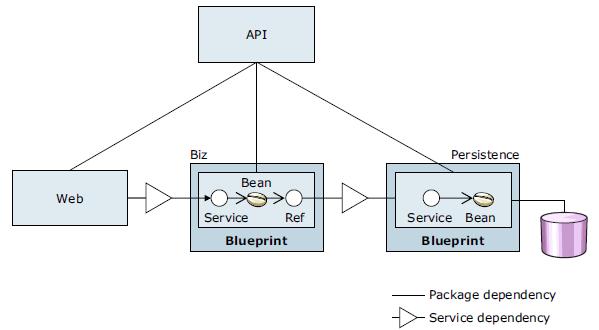
If an OSGi application provides or requires any external services and references, these are explicitly made available by declaring them in an application manifest. The application manifest describes modularity at the application level in a similar way to OSGi headers in a bundle manifest file that define modularity at the bundle level.
A single main application project, itso.bank.app, holds a descriptor META-INF/APPLICATION.MF file, which configures bundles used by the application.
APPLICATION.MF of itso.bank.app application
Application-Name: itso.bank.app Application-SymbolicName: itso.bank.app Application-ManifestVersion: 1.0 Application-Version: 1.0.0.qualifier Manifest-Version: 1.0 Application-Content: itso.bank.api;version="1.0.0", itso.bank.biz;version="1.0.0", itso.bank.persistence;version="1.0.0", itso.bank.web;version="1.0.0"
The other projects define each bundle as follows:
| itso.bank.api | An API bundle containing the interfaces that connect the web logic to the business logic and the business logic to persistence. |
| itso.bank.biz | A business bundle containing the business logic and acts as an intermediary between the presentation logic and the database. |
| itso.bank.persistance | A persistence bundle that encapsulates the JPA-based database access pattern. |
| itso.bank.web | A web bundle for servlets, JSPs, and static content that delegates the actual business functionality to the business bundle. |
The three-tier application split is a standard pattern, but in an OSGi model, it contains a number of OSGi specific twists.
All of the implementation layers are connected through interfaces only. OSGi helps to verify concrete classes are not visible. Thus, individual module developers can only choose to use the provided interfaces. It is a best practice to minimize class dependencies and to ensure unit testability. To obtain concrete implementation of the service interfaces, module developers can use the OSGi service registry.
As a second step, we use a Blueprint to provide the fine-grained dependency injection that separates the wiring of business beans to and from services from their implementation.
Finally, there is the API bundle, which warrants a closer look. In a traditional Java EE style development, we might have included the interfaces in the bundles that also provide the implementation. Alternatively, in OSGi development, we focus more on deciding on packaging and module boundaries. The key criterias define responsibilities and frequency of change across the entire module lifecycle.
Providing the service or entity interfaces and implementing the interfaces are two separate concerns. For example, with the persistence interface (besides a JPA-based persistence implementation mechanism), we can investigate other mechanisms that accesses a no-SQL persistence store or a flat file. Separating the concerns earlier in the process pays off, rather than packaging the interfaces in each separate implementation.
The frequency of change also distinguishes interfaces and implementation. Interfaces change less often because the cost for change is high and because client code can be broken are. Alternatively, the hidden implementation classes change more frequently without requiring interface changes, in particular, as result of defects. Thus, separate packaging conceptually means we can update the implementation without changing the interface bundles. Replacing interface classes can never be done seamlessly, but replacing a service implementation can.
Exporting OSGi applications
To export an OSGi application from the IBM Assembly and Deploy Tools for WebSphere Administration from the Enterprise application view:
- Select the main OSGi application (itso.bank.app in this case), right-click itso.bank.app and then click Export | Export.
- From the context window, click OSGi Application (EBA) application type.
- Enter the location of the exported file in the To EBA file field. The .eba extension is added automatically to this file. Click Finish. Figure 27-7 shows the OSGi application export window.
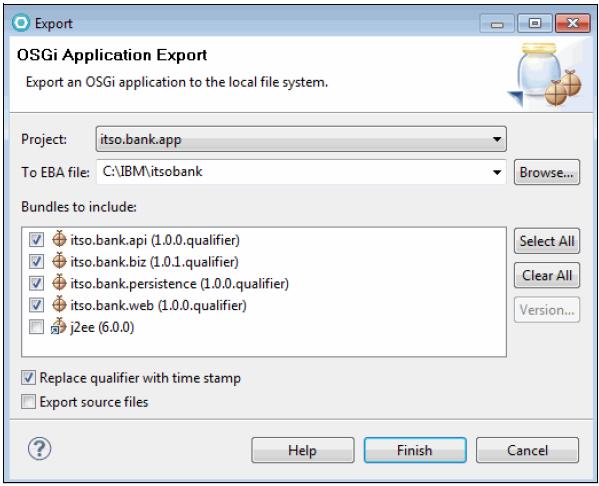
An OSGI package for deployment is built and validated. In this case, a file called c:\IBM\itsobank.eba is created. We can inspect this file for its content and generated descriptor files. Notice that if you select the Replace qualifier with time stamp option, the generated versions and bundles name qualifier part is a time stamp.
- Application-Version: 1.0.0.201206141321
- itso.bank.biz_1.0.0.201206141321.jar
When generating an application without using this option, the files are saved with the following names:
- Application-Version: 1.0.0.qualifier
- itso.bank.biz_1.0.0.qualifier.jar
We can also use other tools to build your OSGi applications, such as Ant or Maven, and automate them with wsadmin scripts.
Refer to the following web sites:
- http://ant.apache.org
- http://maven.apache.org
Additional considerations when exporting OSGi applications
Because of the complexities of the OSGi class loader, give special consideration to importing an exported package. When a package is exported, the package can be used by a separate bundle before the exported bundle is even started. This situation can be a problem when singletons and static fields are used because an imported class is loaded by a separate class loader than the class loader used by the bundle. This creates separate instances of the service object.
For example, suppose bundleA exports a service object responsible for generating sequential order numbers. Also, suppose that three other bundles import and use that service object for generating order numbers. Those three other bundles use the framework class loader and share the same instance of the service object. If bundleA also imports the package, it also uses the same instance. However, if bundleA does not import the package, the bundle class loader instantiates a new instance of the service object and possibly produces a duplicate list of order numbers.
So the practices noted indicate that you typically must import any packages that you export to reduce the number of copies of that package in memory and to ensure the object instances come from the same class loader.
Deploying OSGi applications
We can deploy an OSGi application by adding an enterprise bundle archive asset to a business-level application. The deployment can be done using the dmgr console or wsadmin. Installing through the dmgr console is useful when dealing with complex application structures involving multiple versions and sharing. Using the dmgr console for the first installation is also useful for capturing script commands for future use with wsadmin.
OSGi applications are packaged in enterprise bundle archive files. Deploying applications packaged this way involves completing the following steps:
- Import the enterprise bundle archive file as an asset.
- Add that asset to the business-level application as a composition unit.
Importing the enterprise bundle archive file as an asset
To import the enterprise bundle archive file as an asset:
- In the dmgr console, click...
-
Applications | Application Types | Assets | Import
Select the itsobank.eba file exported earlier.
- In the wizard, accept all the defaults.
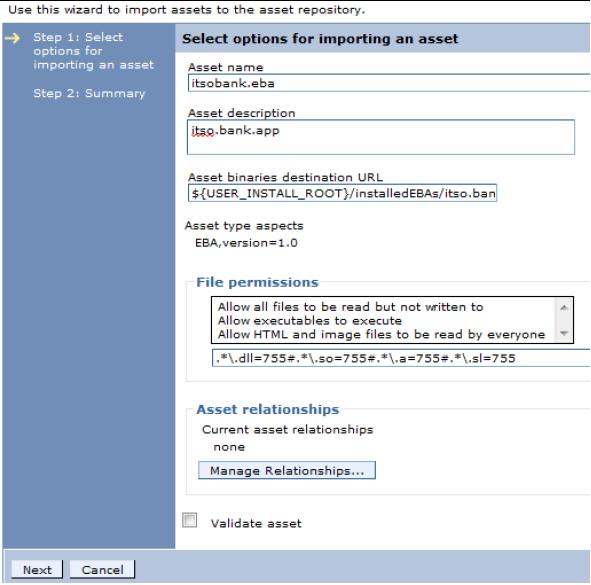
- In the summary step, click Finish to import the asset. Enterprise bundle archive asset conversion and resolution warnings or other information might display in the upper-left corner.
- After processing is complete and without error, save your changes. For OSGi applications, provisioning happens when importing the asset. As a result of provisioning, bundles might need to be retrieved from a bundle repository (internal or external). This process needs to be complete before the asset can be added to a business-level application. However, downloads are triggered only after the asset import is saved. Thus, saving the changes after importing the asset is required.
Add the enterprise bundle archive asset to the business-level application
To add the enterprise bundle archive asset to the business-level applications:
- To create a new empty business-level application...
-
Applications | Application Types | Business-level applications | New
Enter a name for the application. ITSOBank Systems is used in this example. Click Apply.
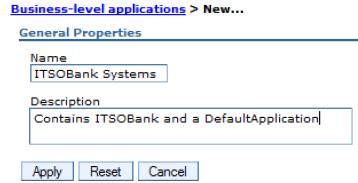
In the business-level application detail panel, click Add | Add Asset in the Deployed Assets section.
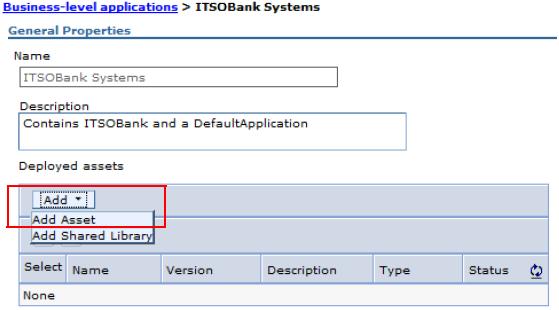
- Choose the asset that was created.
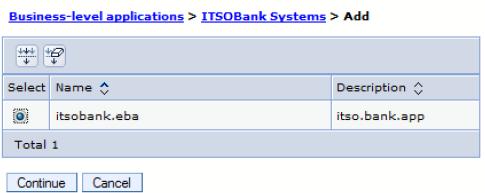
- A wizard starts the new composition unit that will be created. In the wizard, the first step is to set the options for the composition unit
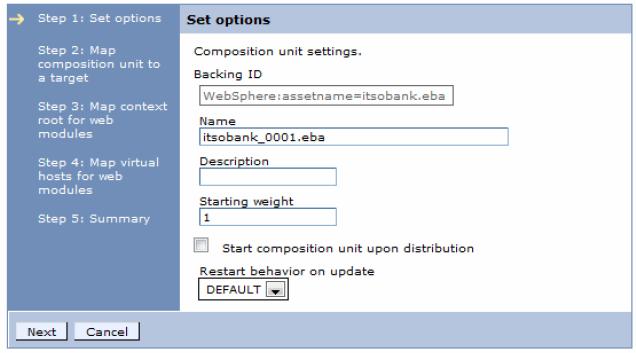
In the asset wizard, the following fields are displayed. The following list describes the fields:
- Backing ID: Displays the unique identifier for the composition unit registered in the application domain. We cannot change this setting.
- Name: Name for the composition unit.
- Starting weight: Specifies the order in which composition units are started when the server starts. The composition unit with the lowest number is started first.
- Start composition unit upon distribution: Whether to start the composition unit when it is distributed to other locations. Applies only to assets and shared library composition units.
- Restart behavior on update (of the composition unit):
- ALL: Restarts the composition unit after the entire composition unit is updated.
- DEFAULT: Restarts the composition unit after the part of the composition unit is updated.
- NONE: Does not restart the composition unit after the composition unit is updated.
- Click Next.
- While still in the asset wizard, its second step is to map the composition unit to a target. Select the server on which the itso.bank.app application will run.
- The third step within the asset wizard is to map the context root for the web modules. Select the Context Root to which the itso.bank.app is to be mapped (default is /itsobank).
- The fourth step within the asset wizard is to map the virtual hosts for the web modules. Select the desired virtual host.
- In the Summary page of the wizard, click Finish.
- Save the changes.
Now we can start the business-level application. There are other wizard steps depending on the bundles and archives contained in your OSGi application.
There are some restrictions for OSGi application deployment:
- An enterprise bundle archive file can be imported into only one asset.
- An enterprise bundle archive asset can be added to only one business-level application.
- One or more composite bundle extensions can be added to a composition unit.
We can also use wsadmin to deploy the OSGi application, it is the common method used in a production environment.
Administrating OSGi applications
In this section, we focus on the OSGi application update, adding a new bundle to the bundle repository, and OSGi application security. More information: the OSGi application administration, refer to the following website: http://www14.software.ibm.com/webapp/wsbroker/redirect?version=phil&product=was-ex press-dist&topic=ta_admin
Updating OSGi applications
After you import your OSGi application as an asset, newer versions of the bundles or composite bundles the asset uses might become available. We can configure the deployed asset to use an updated version, specific bundle version, or to pull in the latest compatible version. WAS does not update the asset to a newer version automatically.
Before you update an OSGi application, ensure the new update bundles have a valid and updated version value. If the new bundle version is the same as the old bundle version, the OSGi run time treats the original version and the new version interchangeably (despite potentially different build numbers).
In this example, we update the ITSO Bank OSGi application
Add the updated bundle or composite bundle to a bundle repository
To update the ITSO Bank application, the new bundle is added to the internal OSGi bundler repository:
- In the dmgr console click Environment | OSGi bundle repositories | Internal bundle repository.

- Click New, and in the Specify path field, enter the path to the new bundle. Choose to specify a path on your local computer or on the remote network manager environment.
In this case, we use the itso.bank.biz bundle v1.0.1 that was exported from IBM Assembly and Deploy Tools for WebSphere Administration. This bundle is a single JAR file.
- Click OK, and save the configuration.
Updating bundle versions in a deployed OSGi application
After the new bundle is added to the repository, configure the ITSO Bank application to use it explicitly, using the following steps:- Click Applications | Application Types | Assets, and choose the ITSO Bank application.
- Under the Additional Properties section, click the Update bundle versions in this application link.
- From the new form, choose the new version of the itso.bank.biz bundle, as shown on
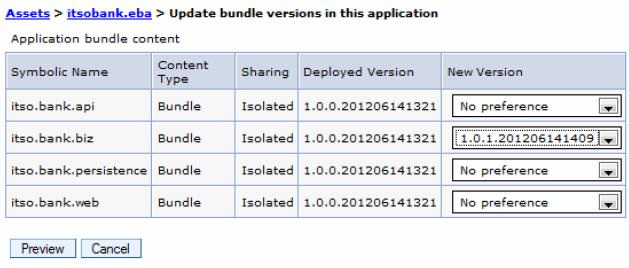
Select the version: The drop-down menus list all the available versions plus the No preference option. Selecting a specific version instructs the provisioning system to use exactly that version for the update. Selecting No preference instructs the provisioning system to find the highest version that works with the other selections.
With both selections, the new version must fall into the range specified in the application manifest. For example, the following application content specifies that only bundle versions from 1.0.0 but less than 2.0.0 are admissible during provisioning and during updates:
-
Application-Content: itso.bank.biz;version="[1.0.0,2.0.0)"
- If no errors occur during processing, a message displays that selected bundle versions can be resolved. Click Create.
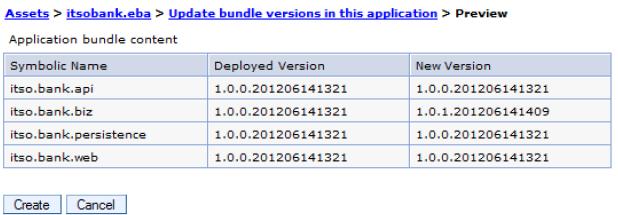
At this time, the configured bundles are downloaded from repositories, in this case from an internal OSGi repository on WAS. The OSGi run time must cache the bundles locally so that applications are not affected by changes to the bundle repositories. This process of downloading the new versions to create local copies can take a small amount of time with external repositories or large bundles, but is mostly instantaneous when working with the internal bundle repository. We can check the status of downloads from the asset detail window or the composition unit detail window.
- Save your changes to the master configuration. Checking the status of the OSGi composition unit and update
We can check the update status of the OSGi composition unit in the dmgr console:
- Click Applications | Application Types | Business-level applications | application_name | composition_unit_name.
- Check the deployment status. It is displayed under General Properties and then OSGi application deployment status.

The OSGi composition unit status: There are four distinct deployment statuses for an OSGi composition unit:
- Using the latest OSGi application deployment.
- New OSGi application deployment not yet available because it requires bundles that are still downloading.
- New OSGi application deployment available.
- New OSGi application deployment cannot be applied because bundle downloads have failed.
- If you plan to update the composition unit at this time, we can update the OSGi composition unit so the business-level application uses the newer configuration. Click Update to latest deployment under...
-
Business-level applications | ITSOBank application | ITSOBank eba asset
More information: Updating OSGi applications
Secure OSGi applications
Securing OSGi applications in WAS is similar to securing enterprise applications. The following options are available for use:In the dmgr console, Click Applications | Application Types | Business-level applications | application_name | [Deployed assets] Add | Add Asset | asset_name | Wizard step: Map security roles to users or groups – Use application security with web application bundles. Define security constraints in web.xml for a web application bundle. – Configure bean security in the Blueprint XML file.
This is new feature introduced in WAS V8.5. You configure security by defining one or more <access-constraint> elements, inside the <bean> element of Blueprint XML file of your OSGi application.
An example of bean security of an OSGi application
<bean class="com.sample.secureBeanImpl"> <sec:access-constraint role="ROLE1" /> <sec:access-constraint method="getID" role="ROLE2" /> </bean>
The two levels of security configuration are: • Configuring bean-level security: In Example 27-3, the methods of the secureBean1 bean are accessible only by users assigned the role called ROLE1. • Configuring method-level security: In Example 27-3, the getID method of the secureBean1 bean is accessible only by users assigned ROLE2. – Use application security with EJB bundles. Enforce any bean method security settings in the ejb-jar.xml file for an EJB bundle.
More information: securing OSGi application, refer to the following website: http://www14.software.ibm.com/webapp/wsbroker/redirect?version=phil&product=was-ba se-iseries&topic=ta_sec